An overhang on a metal roof refers to the part of the roof that extends past the exterior walls of a building. It provides shade and protection from rain to the walls and windows and allows water to drip clear of the foundation.
How much overhang on a metal roof is optimal? A metal roof overhang shields walls and windows from rain. It also helps water drip free of the foundation.
Getting the overhang size right matters for looks and function. Too little allows water damage. Too much looks awkward.
A 12-24 inch overhang, in compliance with building codes, safeguards against water damage by preventing rain and snow from infiltrating siding.
This balanced approach ensures both structural protection and aesthetic appeal. In colder climates, adjusting the overhang becomes crucial to protect the roof substrate from increased snowfall.
Key Takeaways
- Maintain a 1-inch overhang for gutters on a metal roof.
- Facilitates effective water drainage.
- Guards against fascia damage.
- Protects the home’s foundation by preventing water drips.
Overhang Length Matters
When it comes to designing outdoor spaces, the length of an overhang plays a crucial role. A longer overhang doesn’t just add aesthetic appeal, it serves a functional purpose by providing more shade.
This extra shade is key to keeping the surroundings cooler, making the outdoor area more comfortable and enjoyable.
Climate Determines An Appropriate Length
The climate sets the right length for things. In hot places, clothes are short and in cold ones, they’re long. Plants adapt too tall in rain, short in drought. It’s nature’s way, a simple dance with the weather.
How Much Metal Roof Overhang Do You Need?
Contractors installing metal roofing panels usually try to avoid leaving an overhang around the roof’s edges because those edges will bend under the weight of an enormous load.
On the other hand, a metal roof typically has an overhang of only four inches. Roofers may add drip edge flashing to the modest overhang to prevent water damage by keeping moisture from leaking.
You can install wood-framed eaves extending the overhang by up to a foot to support your metal panels.
This helps keep additional snow or ice weight so the panels don’t bend and draw moisture away from your home.
Does The Slope Matter?
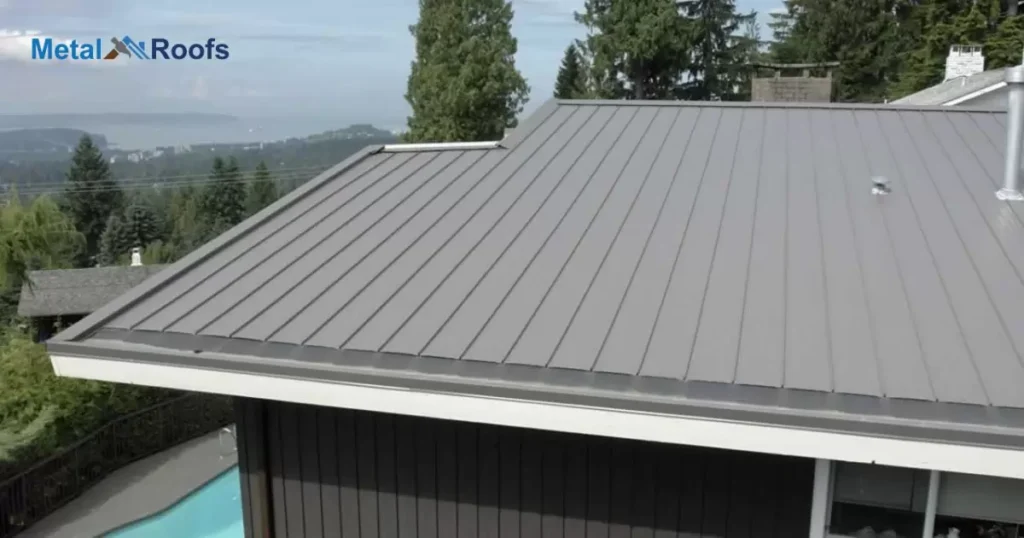
When you hit the slopes, the angle matters. Steeper slopes mean faster rides. A gentle slope is good for beginners; it’s like a nature-made training ground. If you seek thrills, go steep, but be ready for the speed.
The slope affects your skiing or snowboarding experience. Sharp angles make you zoom, mild ones let you take it slow. So, yes, the slope matters.
Whether you’re a newbie or a speed demon, it’s the slope that sets the tone for your snow adventure.
Metal On Any Pitch
Metal on any pitch the raw power of sound breaking boundaries. The gritty roar of electric guitars to the thunderous beat of drums, it’s a symphony of defiance.
No constraints, no limits, just the unbridled energy of metal echoing across every conceivable musical landscape.
In the world of metal, genres blend and clash like titans in an epic battle. The relentless pulse of the bass resonates with rebellion, while the piercing wail of vocals cuts through the air like a warrior’s battle cry.
Metal on any pitch is a sonic rebellion that transcends the conventional, a sonic storm that refuses to be confined.
Little Metal Roof Overhang
A small metal roof overhang offers excellent protection from the elements. It shields your home’s exterior from rain, snow, and harsh sunlight, preventing potential damage.
This overhang provides a practical solution, directing water away and keeping your entryway dry.
In addition to its functional benefits, a little metal roof overhang adds a touch of style to your home.
It enhances curb appeal, giving your house a polished look. This simple yet effective feature not only serves a purpose but also contributes to the overall aesthetics of your property.
Metal Roof Overhang Too Long
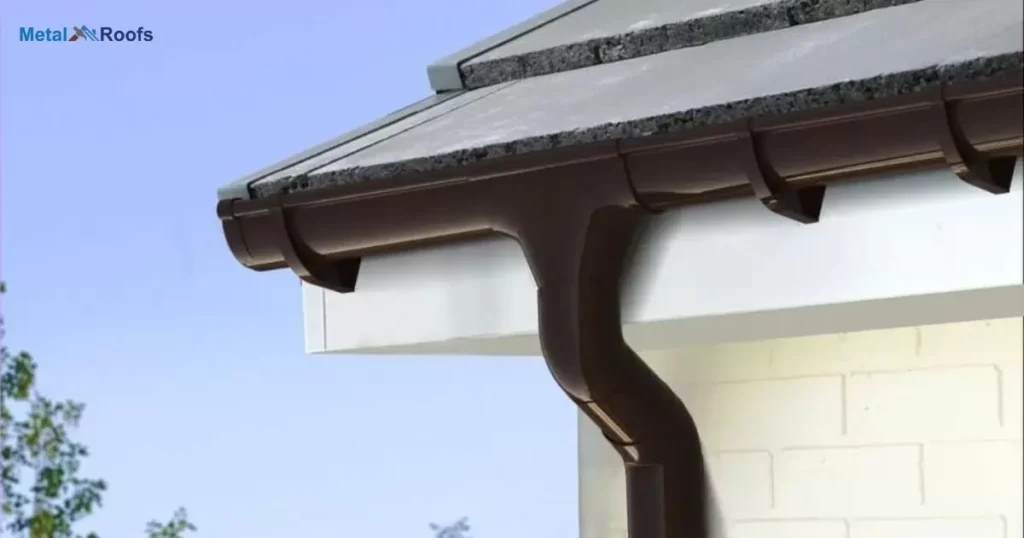
If your metal roof overhang seems too long, it can lead to problems. Water may not drain properly, causing potential leaks. The extended overhang might also strain the roof structure, risking damage in harsh weather.
To fix this, assess the overhang length and trim if necessary. Consider consulting a professional for proper adjustment. It’s a simple solution that prevents bigger issues down the road.
Straight Roof Steel Overhangs
Straight roof steel overhangs provide practical benefits for buildings. These extensions shield structures from harsh weather, preventing rain and sunlight damage.
They also offer a cost-effective solution for enhancing a building’s durability. These overhangs contribute to energy efficiency.
Shading windows and walls reduces the need for excessive cooling in hot weather, resulting in lower energy consumption.
In conclusion, straight roof steel overhangs not only serve a protective role but also promote sustainability and economic savings for building owners.
Metal Roof Overhang Detail
When it comes to a metal roof overhang, the details matter. The overhang, that extra bit of roof extending beyond the walls, does more than just look good.
It shields your home from rain, keeps the sun at bay, and adds a touch of style.
Properly designed, a metal roof overhang ensures rainwater doesn’t sneak in and gives you a shaded spot to enjoy.
It’s not just about aesthetics, it’s about practical protection for your home. So, when discussing roofing, pay attention to the overhang of the small details that make a big difference.
Overhang On Metal Roof For Gutters
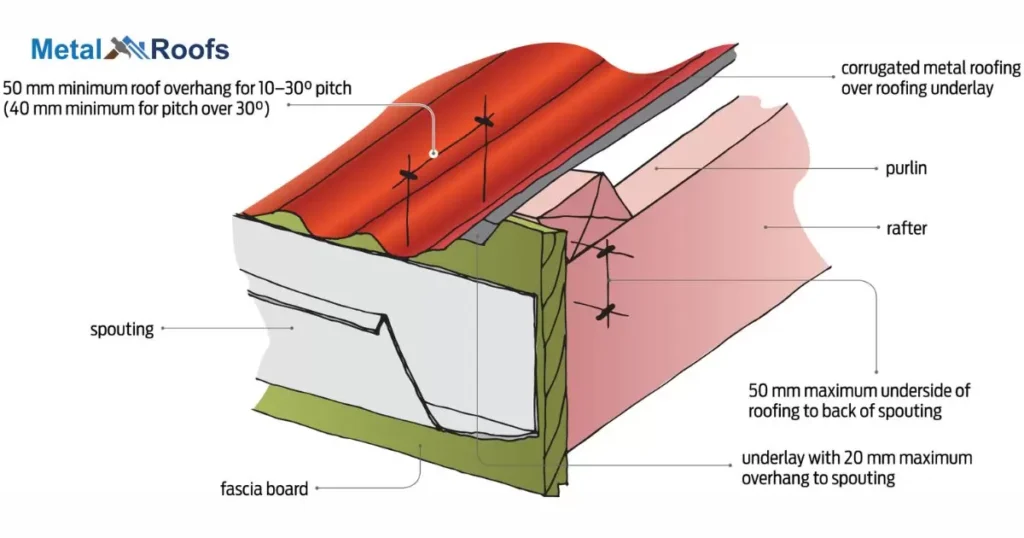
When installing gutters on a metal roof, having an overhang is crucial. The overhang directs rainwater away, preventing damage.
It ensures proper drainage, keeping your roof and foundation safe from potential issues. An overhang on a metal roof for gutters is a practical solution for effective water management.
How Far Should Roof Sheets Overhang Guttering?
When it comes to roof sheets and guttering, the overhang matters. Ideally, roof sheets should overhang guttering by about 25 to 50 millimeters.
This overhang helps direct rainwater away from your house, preventing potential damage.
Importance Of Gutters
Gutters are crucial for homes. They divert rainwater away, preventing damage.
Without them, water can seep into foundations, causing costly issues. Regular maintenance ensures they do their job well, safeguarding your home.
Factors to Consider for Overhang on Metal Roofs
Climate and Weather Conditions
Assess snow and wind loads to determine appropriate overhang dimensions.
Building Codes and Regulations
Adhere to local codes specifying maximum allowable overhangs based on structural factors.
Structural Integrity
Ensure the building’s frame can support the additional weight and stresses of overhangs.
Water Management
Design overhangs to direct water away from the building, incorporating gutters and drainage.
Aesthetic Considerations
Balance architectural style and desired appearance when sizing and shaping overhangs.
Solar Exposure
Optimize overhangs to regulate sunlight for energy efficiency and occupant comfort.
Cost Implications
Consider material and labor costs in relation to overhang length for a cost-effective design.
You can design and install overhangs on metal roofs that not only improve aesthetics but also guarantee longevity and functionality in a range of environmental circumstances by carefully taking these factors into account.
It is advised to consult experts, such as structural engineers and architects, to ensure a thorough and secure design.
Recommended Overhang Measurements for Different Gutter Types
| Gutter Type | Recommended Overhang | Additional Information |
| K-style Gutters | 1 inch | Helps direct water away effectively from the roof edge. |
| Half-round Gutters | 1.5 inches | Ensures optimal water flow and prevents potential issues. |
When it comes to gutter installations, overhang measurements play a crucial role. For K-style gutters, a 1-inch overhang beyond the roof edge is recommended. This helps direct water away effectively.
Half-round gutters, a slightly larger overhang of 1.5 inches is advised. This added margin ensures optimal water flow and prevents potential issues.
These overhang measurements may vary based on specific conditions, so it’s wise to consult with a professional for the best fit.
Installation Tips for Proper Overhang on Metal Roofs
When installing a metal roof, ensure the overhang is right. Overhang protects walls from water and adds style. Measure and mark the overhang distance precisely. Use a straight board as a guide for consistency.
Attach the metal panels carefully. Start at one end, align, and secure. Check overhang as you go. Nail securely but avoid overdriving. A proper overhang ensures durability and a polished look for your metal roof.
Common Mistakes to Avoid in Overhang Measurement
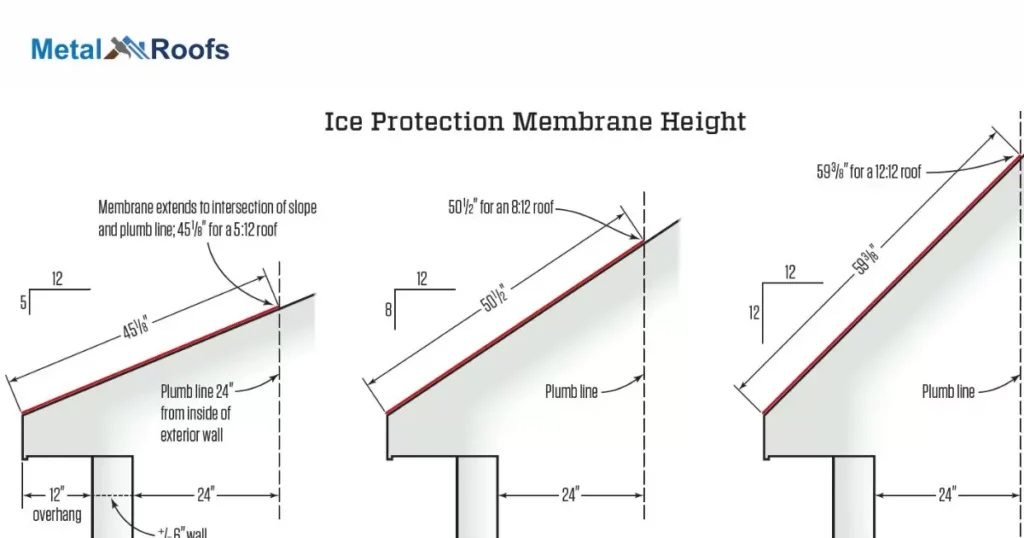
| Common Mistakes in Overhang Measurement | Recommendations |
| Using a Sagging or Tilted Tape Measure | Ensure the tape measure is straight and not sagging or tilted. |
| Starting Measurement from the Hook | Begin measuring from the edge, not the hook, for accuracy. |
| Inconsistent Units | Stick to one unit of measurement (inches or centimeters) for consistency. |
| Sloppy Measuring | Take precise measurements to avoid inaccuracies. |
| Lack of Consistency | Maintain consistency in measurement units for clarity |
Measuring overhang might seem simple, but common mistakes can throw off your accuracy.
First, ensure your tape measure is straight, not sagging or tilted. Sloppy measuring leads to incorrect readings.
Next, mind the starting point. Beginning at the edge, not the hook, avoids false measurements. Lastly, consistency matters.
Stick to one unit whether inches or centimeters mixing them creates confusion. Keep it straight, start right, and stay consistent for precise overhang measurements.
Metal Roof Drip Edge
Sure! The metal roof drip edge is an essential component because it plays a key role in managing water runoff. It functions by extending beyond the roof’s edge, effectively guiding water away from the fascia and preventing it from infiltrating underneath the roofing material.
Proper installation of the drip edge is crucial as it not only protects the fascia but also helps prevent water damage to the structure.
It’s important to adhere to manufacturer guidelines when installing the drip edge to ensure it functions effectively in directing water away from the roof and safeguarding the building from potential damage.
Metal Roofing Overhang
Metal roofing overhang is crucial for protection and aesthetics. The recommended overhang is 1 to 2 inches, but it varies based on factors like climate and roof pitch.
In areas with heavy rainfall or snow, a larger overhang may be necessary to divert water away effectively.
Steeper roofs often require shorter overhangs due to their angle, while flatter roofs might need larger ones. Always follow local building codes and manufacturer guidelines for the best results.
Combining the overhang with a drip edge can enhance water runoff and prevent damage to the fascia and gutters.
Metal Roof Overhang Detail
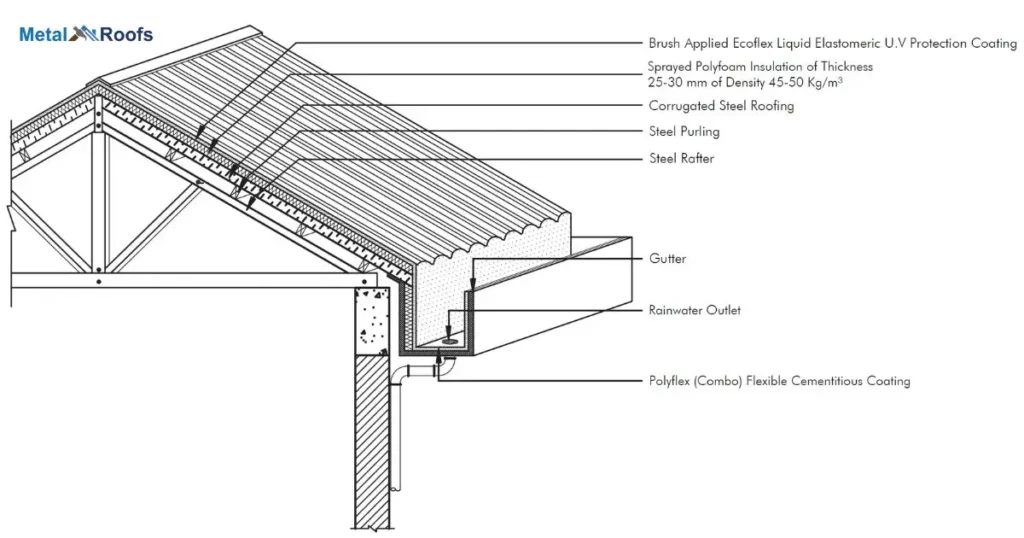
The overhang on a metal roof is crucial. It typically ranges from 1 to 2 inches. This overhang protects the fascia and directs water away.
Climate and roof pitch influence the overhang size. Steeper roofs might need shorter overhangs.
Consult local codes and manufacturer guidelines. Drip edges enhance overhang effectiveness. T
hey direct water into gutters. Adjust overhangs based on design preferences. Ensure they complement gutter systems well. Overall, a balanced overhang is key for metal roof durability and aesthetics.
Frequently Asked Questions
What is the typical overhang for a metal roof?
The overhang for a metal roof is usually 12 to 18 inches. It provides shade and protects walls from rain. A well-sized overhang enhances durability and weather resistance.
Does metal roof need drip edge?
Yes, a metal roof needs a drip edge. It prevents water from getting under the roofing material. Without it, water can seep into the structure, causing damage over time. Install a drip edge for a longer-lasting and secure metal roof.
How much overhang on metal roof for gutters?
When installing gutters on a metal roof, allow a 1-inch overhang to ensure proper water drainage. This small extension helps prevent water from dripping down the fascia, protecting your home’s foundation.
Conclusion
Properly sizing the metal roof overhang is key for performance, aesthetics. Follow building code’s 12-24 inch guideline for a standard overhang.
Adjust for heavy snow needing more coverage. Balance function and attractive proportions.
Installing metal roofing can seem daunting but with good planning, quality materials and smart techniques, durable, attractive results happen.
Prepare correctly, get expertise as required and follow manufacturer instructions.











